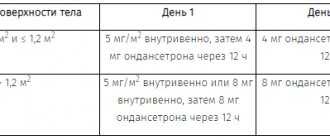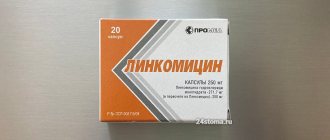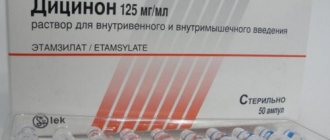Pharmacological properties of the drug Pregnavit
Combined multivitamin preparation containing minerals. The vitamins and microelements included in the drug compensate for the deficiency of these compounds in the body, in particular with an increased need for them during pregnancy and lactation. The action of Pregnavit is determined by its components. Retinol (vitamin A) is necessary for the biosynthesis of rhodopsin, maintaining the integrity of epithelial cells, and growth of the body (including the fetus during pregnancy). Colecalciferol (vitamin D3) regulates the metabolism of calcium and phosphorus in the body, as well as the process of building bone structure; prevents the development of rickets in newborns. Thiamine (vitamin B1) as a coenzyme is involved in carbohydrate metabolism and the functioning of the nervous system. Riboflavin (vitamin B2) is the most important catalyst for the processes of cellular respiration and visual perception. During pregnancy, it limits the impact of teratogenic factors. Pyridoxine (vitamin B6) as a coenzyme takes part in protein metabolism and the synthesis of neurotransmitters. During pregnancy, it is especially necessary for women who have previously taken oral contraceptives, which deplete the pyridoxine depot in the body. Cyanocobalamin (vitamin B12) is involved in the synthesis of nucleotides and is an important factor in normal growth, hematopoiesis and development of epithelial cells; necessary for folic acid metabolism and myelin synthesis. Nicotinamide is involved in the processes of tissue respiration, fat and carbohydrate metabolism. Ascorbic acid (vitamin C) ensures collagen synthesis; participates in the formation and maintenance of the structure and function of cartilage, bone tissue, teeth; affects the formation of hemoglobin and the maturation of red blood cells. The physiological level of ascorbic acid in a pregnant woman’s body is of great importance for the normal development of the placenta, as well as for increasing the body’s resistance to infections. Pantothenic acid, as a component of coenzyme A, plays an important role in the processes of acetylation and oxidation; promotes the construction and regeneration of epithelium and endothelium. Folic acid takes part in the synthesis of amino acids, nucleotides, nucleic acids; necessary for normal erythropoiesis; during pregnancy, it performs, to a certain extent, a protective function in relation to the action of teratogenic factors. Tocopherol (vitamin E) has antioxidant properties; maintains the stability of red blood cells, prevents hemolysis; has a positive effect on the function of the gonads, nervous and muscle tissue. Iron is involved in erythropoiesis and, as part of hemoglobin, ensures the transport of oxygen to tissues. Calcium is necessary for the formation of bone matter, coagulation processes, the transmission of nerve impulses, contraction of skeletal and smooth muscles, and normal myocardial activity.
Pregnavite
A combined drug, the effect of which is due to the effects of the vitamins and minerals included in its composition.
Retinol (vitamin A) is necessary for the synthesis of rhodopsin, maintaining the integrity of epithelial cells, growth of the body, incl. fetus during pregnancy.
Colecalciferol (vitamin D3) regulates the exchange of Ca2+ and phosphorus in the body, as well as the process of building bone structure; prevents the development of rickets in a newborn.
Thiamine (vitamin B1) as a coenzyme is involved in carbohydrate metabolism and the functioning of the nervous system.
Riboflavin (vitamin B2) is an essential catalyst for cellular respiration and visual perception. Reduces the percentage of congenital deformities.
Pyrodoxin (vitamin B6) as a coenzyme takes part in protein metabolism and the synthesis of neurotransmitters. During pregnancy, it is necessary for women who have previously taken oral contraceptives, which deplete pyridoxine reserves in the body.
Cyanocobalamin (vitamin B12) is involved in the synthesis of nucleotides and is an important factor in normal growth, hematopoiesis and development of epithelial cells; necessary for folic acid metabolism and myelin synthesis.
Nicotinamide is involved in the processes of tissue respiration, fat and carbohydrate metabolism.
Ascorbic acid (vitamin C) ensures collagen synthesis; participates in the formation and maintenance of the structure and function of cartilage, bones, teeth; affects the formation of Hb, the maturation of erythrocytes. The physiological level of ascorbic acid in the body of a pregnant woman is of great importance for the normal development of the placenta, as well as increasing the body's resistance to infections.
Pantothenic acid, as a component of coenzyme A, plays an important role in the processes of acetylation and oxidation; promotes the construction and regeneration of epithelium and endothelium.
Folic acid takes part in the synthesis of amino acids, nucleotides, nucleic acids; necessary for normal erythropoiesis. During pregnancy, it performs, to a certain extent, a protective function against teratogenic factors.
Tocopherol (vitamin E), having antioxidant properties, protects various substances from oxidation; maintains the stability of red blood cells, prevents hemolysis; has a positive effect on the functions of the gonads, nervous and muscle tissue.
Fe is involved in erythropoiesis and, as part of Hb, ensures the transport of oxygen to tissues.
Ca2+ is necessary for the formation of bone matter, blood clotting, the process of transmitting nerve impulses, contraction of skeletal and smooth muscles, and normal myocardial activity.
The vitamins and minerals contained in the drug compensate for the deficiency of these compounds in the body, in particular, when the need for them increases during pregnancy and lactation.
Pregnavit
[I] - Instructions for medical use were approved by the pharmacological committee of the Ministry of Health of the Russian Federation on March 14, 2002.
Pregnavit is a combined multivitamin preparation containing minerals. The vitamins and minerals included in the drug compensate for the deficiency of these compounds in the body, in particular, when the need for them increases during pregnancy and lactation.
The effect of the drug Pregnavit is determined by its constituent components.
Retinol (vitamin A) activates redox processes, participates in the energy supply of metabolism, is necessary for the biosynthesis of rhodopsin, maintaining the integrity of epithelial cells, body growth, incl. fetus during pregnancy.
Colecalciferol (vitamin D3) regulates the exchange of calcium and phosphorus in the body, normalizes the formation of the bone skeleton and teeth in children, and prevents the development of rickets in a newborn.
Thiamine (vitamin B1) as a coenzyme is involved in carbohydrate metabolism and the functioning of the nervous system.
Riboflavin (vitamin B2) is the most important catalyst for cellular respiration processes and is involved in growth processes. During pregnancy, it limits the effect of teratogenic factors.
Pyridoxine (vitamin B6) as a coenzyme takes part in protein metabolism and the synthesis of neurotransmitters. During pregnancy it is necessary for women; who have previously taken oral contraceptives that reduce the depot of pyridoxine in the body.
Cyanocobalamin (vitamin B12) is involved in the synthesis of nucleotides; is an important factor in normal growth, hematopoiesis and development of epithelial cells; necessary for folic acid metabolism and myelin synthesis.
Nicotinamide (vitamin PP) is involved in the processes of tissue respiration, fat and carbohydrate metabolism.
Ascorbic acid (vitamin C) ensures collagen synthesis; participates in the formation and maintenance of the structure and function of cartilage, bones, teeth; affects the formation of hemoglobin and the maturation of red blood cells. The physiological level of ascorbic acid in the body of a pregnant woman is of great importance for the normal development of the placenta, as well as increasing the body's resistance to infections.
Pantothenic acid (vitamin B5) as a component of coenzyme A plays an important role in the processes of acetylation and oxidation; promotes the construction and regeneration of epithelium and endothelium.
Folic acid (vitamin Bc) takes part in the synthesis of amino acids, nucleotides, nucleic acids; necessary for normal erythropoiesis. During pregnancy, it performs, to a certain extent, a protective function in relation to the action of teratogenic factors.
Tocopherol (vitamin E), having antioxidant properties, protects various substances from oxidation; maintains the stability of red blood cells, prevents hemolysis; has a positive effect on the functions of the gonads, nervous and muscle tissue.
Iron is involved in erythropoiesis and, as part of hemoglobin, ensures the transport of oxygen to tissues.
Calcium is necessary for the formation of bone matter, blood clotting, the process of transmission of nerve impulses, contraction of skeletal and smooth muscles, and normal myocardial activity.
Binavit, solution for intramuscular administration, 2 ml, 10 pcs.
Thiamine
After intramuscular administration, thiamine is quickly absorbed from the injection site and enters the blood (484 ng/ml after 15 minutes on the first day of administration of a 50 mg dose) and is unevenly distributed in the body with its content in leukocytes 15%, erythrocytes 75% and in blood plasma 10 %. Due to the lack of significant reserves of the vitamin in the body, it must be supplied to the body daily. Thiamine penetrates the blood-brain and placental barriers and is found in breast milk. Thiamine is excreted by the kidneys in the alpha phase after 0.15 hours, in the beta phase after 1 hour and in the final (terminal) phase within 2 days. The main metabolites are: thiaminecarboxylic acid, pyramine and some unknown metabolites. Of all the vitamins, thiamine is stored in the body in the smallest quantities. The adult human body contains about 30 mg of thiamine: 80% as thiamine pyrophosphate, 10% as thiamine triphosphate and the rest as thiamine monophosphate.
Pyridoxine
After intramuscular injection, pyridoxine is quickly absorbed from the injection site and distributed in the body, acting as a coenzyme after phosphorylation of the CH2OH group at the 5th position. About 80% of the vitamin binds to blood plasma proteins. Pyridoxine is distributed throughout the body, penetrates the placenta, and is found in breast milk. It accumulates in the liver and is oxidized to 4-pyridoxic acid, which is excreted by the kidneys within a maximum of 2-5 hours after absorption.
The human body contains 40-150 mg of vitamin B6 and its daily elimination rate is about 1.7-3.6 mg with a replacement rate of 2.2-2.4%.
Cyanocobalamin
Cyanocobalamin, after intramuscular administration, binds to transcobalamins I and II and is transported to various tissues of the body. The maximum concentration after intramuscular administration is achieved after 1 hour. Communication with blood plasma proteins – 90%. Penetrates the placental barrier and is found in breast milk. Metabolized primarily in the liver to form adenosylcobalamin, which is the active form of cyanocobalamin. It is deposited in the liver, enters the intestines with bile and is reabsorbed into the blood (the phenomenon of enterohepatic recirculation). The half-life is long, excreted mainly by the kidneys (7-10%) and through the intestines (50%). With a decrease in renal function, 0-7% is excreted by the kidneys and 70-100% through the intestines.
Lidocaine
When administered intramuscularly, the maximum plasma concentration of lidocaine is observed 5-15 minutes after injection. Depending on the dose, about 60-80% of lidocaine is bound to plasma proteins. Quickly distributed (within 6-9 minutes) in organs and tissues with good perfusion, incl. in the heart, lungs, liver, kidneys, then in muscle and adipose tissue. Penetrates the blood-brain and placental barriers and is found in breast milk (up to 40% of the concentration in the mother's blood plasma). Metabolized in the liver with the participation of microsomal enzymes with the formation of active metabolites - monoethylglycine xylide and glycine xylide, which have a half-life of 2 and 10 hours, respectively. Metabolic intensity decreases in liver diseases. It is excreted mainly in the form of metabolites by the kidneys and up to 10% unchanged.



